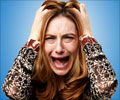Children with bipolar disorder react differently to facial expressions than children without psychiatric disorders, says a study.
The study, led by Daniel P. Dickstein, M.D., director of the paediatric mood, imaging and neurodevelopment program at Bradley Hospital, found that in children with bipolar disorder facial expressions have a greater impact.In the study, 23 children with bipolar disorder and 22 typically developing children without psychiatric disorders between the ages of 7 and 17 years were examined.
The researchers used functional magnetic resonance imaging (MRI), a non-invasive technique that localizes regions of the brain activated during cognition and experience, to scan the children while they ‘encoded’ different facial expressions.
“Although we know a great deal clinically about bipolar disorder in kids, our understanding of its neurobiology is quite limited, making it difficult to design targeted treatments,” Dickstein said.
“We used neuroimaging technology to study the brain-behaviour interactions of children with bipolar disorder in hopes of shedding some light on this relatively unknown area,” he said.
During the MRI scan, the children viewed photos of 32 different actors; eight actors each displaying one of four emotions (angry, fearful, happy and neutral), from standard gray-scale photograph sets of facial expressions.
Advertisement
Thirty minutes after the MRI scan, children were given a surprise out-of-scanner memory task, during which they viewed 48 actors (half of which were seen previously during the MRI and half that were not previously viewed).
Advertisement
Increased activity was also found in the part of the brain (orbitofrontal cortex) liked to irritability when the same children encoded “angry” faces. Brain activity in both instances was significantly greater than in children without bipolar disorder.
Based on the number of correct identifications during the memory task, the team also found that children with bipolar disorder demonstrated reduced memory for emotional faces as compared to children without bipolar disorder – particularly with "fearful" faces.
“This study suggests a neural basis for mania in children, which typically involves unusually irritable or excessively happy moods, and raises questions about whether treatments, therapy or medication could address these brain changes,” Dickstein said.
The study is published in the journal Bipolar Disorders.
Source-ANI
LIN/P











